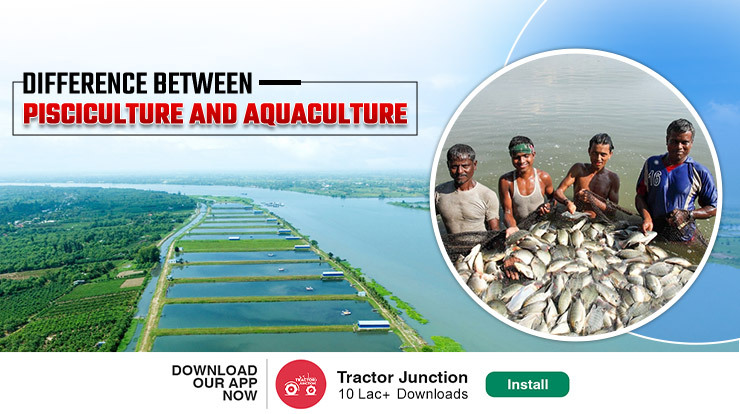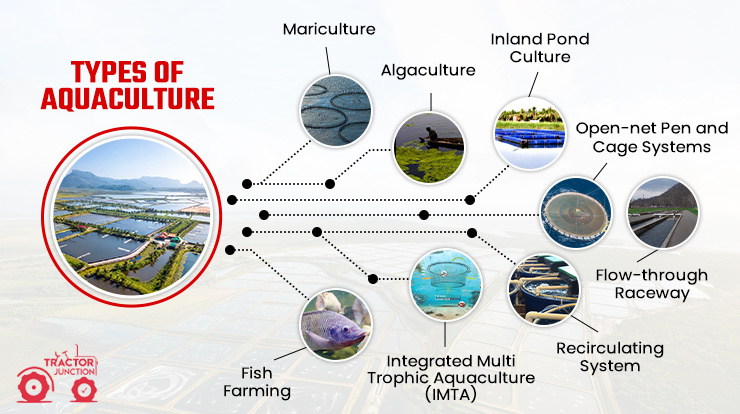
When we talk about pisciculture and aquaculture, we’re looking at two ways of farming in water. Pisciculture is about raising and growing fish, while aquaculture is a bit broader as it includes all kinds of water animals, plants, and sea veggies. So, the main difference is that pisciculture deals with only fish, while aquaculture covers a bit of everything in water. Both of them involve farming these things for people to use, like for food.
Learn more about the difference between pisciculture and aquaculture, practices and their benefits below:
Pisciculture And Aquaculture: All You Need To Know
Pisciculture: Importance And Its Types

Fish are bred and raised in a controlled environment for commercial or recreational purposes in a method known as pisciculture, or fish farming. This technique controls variables like temperature and water quality to guarantee the best possible environment for fish growth. Pisciculture meets the global demand for fish consumption, contributing to environmental sustainability.
Typically done in tanks or ponds, it provides a cost-effective protein source, supporting nutritional needs. Pisciculture also generates income and job opportunities, especially in regions like Asia, addressing unemployment in impoverished areas. Overall, there are many advantages of pisciculture in supplying fish, supporting livelihoods, and sustaining ecosystems.
Importance Of Pisciculture

1. Meeting Global Seafood Demand: Pisciculture is essential in fulfilling the worldwide need for seafood, ensuring a steady and controlled fish supply.
2. Conservation of Wild Fish: By cultivating fish in controlled settings, pisciculture reduces pressure on wild fish populations, promoting balanced ecosystems.
3. Food Security: Pisciculture enhances food security, particularly in areas with limited access to fresh seafood, by offering a dependable source of protein-rich fish.
4. Quality and Safety: Fish farming allows for precise control over the quality and safety of the produced fish, ensuring proper feeding practices and standards.
Types Of Pisciculture

1. Monoculture: In this system, only one type of fish is farmed. It ensures high production and quality, and examples in India include shrimp farming.
2. Polyculture: Also known as composite or mixed fish farming, polyculture involves raising different fish species in a shared pond. It’s beneficial when the species have different feeding habits.
3. Monosex Culture: This type focuses on growing either female or male fishes of a species. An example is Tilapia. Each culture type serves specific purposes in fish farming.
Aquaculture: Importance And Its Types

Farming aquatic animals in controlled habitats, such as fish, shellfish, and plants, for food production and conservation is known as aquaculture. It provides a long-term way to satisfy the growing demand for seafood around the world while reducing the strain on wild fish populations.
In addition to producing food, aquaculture supports many people’s livelihoods and jobs. It does, however, provide certain difficulties, such as invasive species, water contamination, and dangers to coastal ecosystems. Considering these problems, aquaculture continues to play a significant role in the availability of seafood and in creating jobs. Below, let’s explore the benefits of aquaculture:
Importance Of Aquaculture

1. Managed Seafood Production: Without endangering wild populations, aquaculture provides a managed and effective method of producing seafood and other aquatic species.
2. Preservation of Wild Fish: Aquaculture contributes to the preservation of wild fish stocks by raising fish and other aquatic animals in controlled habitats.
3. Preservation of Biodiversity: Aquaculture makes it possible to raise a variety of aquatic species, including those that are vulnerable or endangered, which helps with biodiversity preservation and conservation.
Types Of Aquaculture

Also Read: Types of Farming in India
1. Mariculture – Mariculture involves the use of seawater, either next to an ocean or in ponds separate from the ocean but containing seawater. Organisms bred include molluscs and seafood options like prawns, shellfish, and seaweed. Mariculture products find applications in industries like cosmetics and jewellery.
2. Fish Farming – Fish farming is the most common type, involving selective breeding of fish in freshwater or seawater for food production. It provides a cheap source of protein and is less land-intensive compared to other farming methods.
3. Algaculture – Algaculture cultivates algae and microbial organisms with both animal and plant characteristics. Algae are finding applications in industries, and efforts are being made to develop them as a new source of energy.
4. Integrated Multi-Trophic Aquaculture (IMTA)- IMTA is an advanced system mixing different trophic levels for efficient resource utilisation, emulating natural ecological systems. It recycles nutrients, making the process less wasteful and more productive.
5. Inland Pond Culture – Involves artificial ponds, common in China and the U.S., enhancing oxygen supply and reducing ice formation in winter.
6. Recirculating Systems – Closed chambers where fish and water treatment are separated. Environmentally friendly and efficient, using minimal new water.
7. Open-net Pen and Cage Systems – In open-net pen and cage systems, large mesh cages in water hold fish. These systems found offshore or in lakes, can lead to issues like waste spreading and attracting predators. The cages, using public water, must follow environmental rules and get proper permissions.
8. Flow-through / Raceway – This system is made up of long units where fish are kept. These units have feeding stations. Water is taken from a stream and directed into the units, flowing downstream. At the end, waste is collected and removed. Raceways are often used to raise trout.
Difference Between Aquaculture vs Pisciculture

Now that you have known the basic definitions of pisciculture and aquaculture, let’s learn more about the difference between aquaculture and pisciculture below:
| Basis | Aquaculture | Pisciculture |
| Focuses on | Farming of aquatic species in controlled settings | Breeding and rearing of fish in controlled environments |
| Production Purpose | Food production, conservation, and recreation | Primarily for commercial food production |
| Harvesting Species | Regular harvesting of different aquatic species | Harvesting of specific fish species |
| Sustainability | Helps reduce pressure on wild fish populations | Contributes to sustainable seafood production |
| Global Demand | Addresses the increasing demand for seafood | Contributes to meeting global seafood demand |
Conclusion :
In conclusion, aquaculture and pisciculture play pivotal roles in meeting the global demand for seafood. While pisciculture specifically focuses on breeding and rearing fish for commercial purposes, aquaculture encompasses a broader spectrum, including various aquatic species, plants, and sea vegetables.
Both practices contribute to sustainable seafood production, addressing challenges such as disease prevention and the need for alternative fish meals. Technological innovations, from oral vaccine delivery to closed-loop farming, are shaping the future of these industries. As investments pour into aquatech solutions, the prospects for efficient, sustainable, and transparent aquaculture and pisciculture continue to brighten.
FAQ’s About The Difference Between Pisciculture And Aquaculture
Q1. What Is Pisciculture?
Ans: Pisciculture is about raising and growing fish in controlled places, mostly for people to eat or enjoy, helping meet the demand for fish while being mindful of the environment.
Q2. What Is Aquaculture?
Ans: Aquaculture is water farming, where different aquatic organism and plants are grown in controlled places for food, helping meet the global demand for seafood and being eco-friendly.
Q3. How Do You Differentiate Between Capture Fishing Mariculture And Aquaculture?
Ans: Mariculture is farming in the ocean, and aquaculture is farming various water species in controlled environments for food; each meets seafood demand differently.
Q4. What Is The Difference Between Pisciculture And Aquaculture?
Ans: Pisciculture is fish farming, concentrating on fish breeding, while aquaculture encompasses farming various water species like fish, shellfish, and plants for food in controlled environments.
Q5. What Are The Different Types Of Pisciculture?
Ans: There are three main types of pisciculture in India: Monoculture, Polyculture, and Monosex Culture.
Related Post
DBT in Agriculture
Difference Between Horticulture And Agriculture


